In this second part of our three-part series on the psychology, philosophy and politics of photography, I’m exploring the relationship between photography and politics. One could go as far and argue there is no story — political or not — without visualization a.k.a. images. Images, suggestive in nature, determine a major part of the “spin” a story gets, of the message. So careful with those photographs. Everything you do in life has some underlying political dimension, even the simple pleasure of taking pictures. We just cannot wash the politics out of photography.
(+++ This article is the second part of our three-part series with The Psychology of Photography and not yet published The Philosophy of Photography.)
As we all know, a picture tells a thousand words. An outstanding picture means and tells so much more than just words. Take this photograph below released by the White House, revealing the moment when President Barack Obama was told the shocking news about the massacre at Sandy Hook Elementary School.
This photo needs no words. It visualizes pain, grief and helplessness without a single written word. This simple photo humanizes the mighty U.S. president in a way no political pamphlet or speech could.
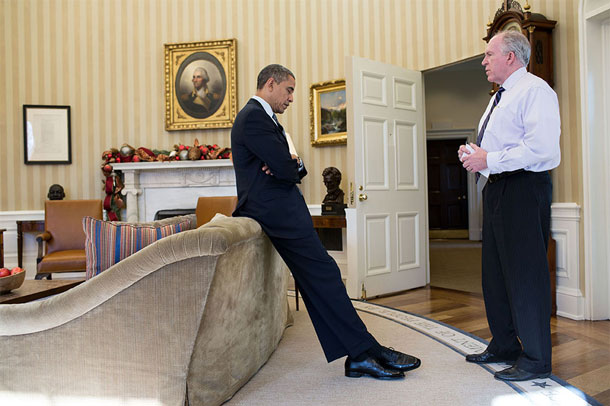
As outlined in our earlier post on White House photographer Pete Souza, Obama’s personal photographer is a master of the art of getting a political message across by means of simple, non-posed, narrative photography.
In a way, however, all photography is political. Because all photography takes place in a social and cultural context and is, even if unintended, a form of suggestive manipulation.
Politics, per definition, is the art or science of influencing people’s beliefs on a civic or individual level. That’s what photography in essence is about: conveying a certain interpretation of a reproduced reality that we take for real.
It is important to be aware of the power of a reproduced reality and its intended or unintended effects on us. The power of the image starts with the framing.
Intentionally cropping off demonstrators at a protest, for instance, suggests a rather isolated protest, whereas the whole uncropped frame including bystanders would suggest a more vehement protest.
Happens all the time in newspapers. We’re only shown “partial reality” — or in other words: part of the whole picture.
Framing is, in essence, a political process, as you are intending/crafting a certain message.
Take this incredibly poignant photo by Getty Images’ John Moore:
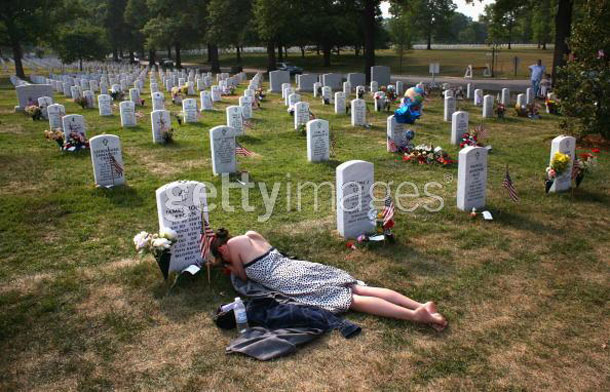
But first, Moore shot this one:

Now this is the image that was published by the New York Times:
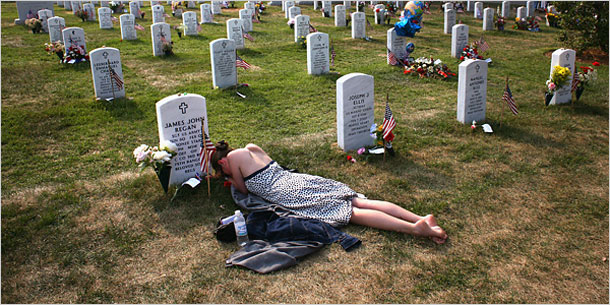
Well it turns out, as you can easily see, that the image is edited.
It is important to understand how this image run by the New York Times works to convey some part of an intended reality, carrying an implicit (political) message. They would not have taken image #74345338 with it’s picnic-flair because of the photo’s so much less somber message. Same place, same time, same topic!
And talking about intentional political messages, what if the camera had a different crop?!…
To speak with political scientist James Johnson:
As the Times presents it, the photograph offers the impression of an isolated moment of sorrow, of a young woman bereft and alone among vast numbers of the dead, among whom is her fiancé. And, for Ms. McHugh this may well have been the case; she may well have been oblivious to any and everything that might have been transpiring around her. She very likely was subsumed in grief. How did John Moore and editors at the Times elicit that situation?
John Moore had uploaded two photographs of Mary McHugh onto the Getty Images site. Both carry the same running title: “War Dead Honored on Memorial Day Weekend” with image #74345338 and #Image #74345339.
Judging by the consecutive image numbers, Moore apparently took the top picture first, then walked past, behind Ms. McHugh, shifting perspective for the lower one. This move not only highlighted her position perpendicular to the row of grave stones, but allowed Moore to focus solely on Ms. McHugh, excluding nearly all the other grieving individuals and groups who populate the first image. Even so, Ms. McHugh is still not quite alone. Someone, presumably the photo editors at the Times, has cropped the photograph, removing what I estimate to be the top 20% of its original height and, in the process, eliminating still other visitors to the cemetery and reducing the distracting vastness of the scene.
Viewing the final image in the Times creates the sensation of witnessing, perhaps of intruding on or interrupting an intensely intimate moment. No doubt the moment captured in the photograph was intensely intimate for Ms. McHugh. No doubt too, the photograph conveys something of that. But it does so only through the judgements and choices of the photographer and his editors. The poignancy here was not “found.” It was elicited, evoked, drawn out, and offered to us.
Images are constantly being used in some political form or another to shape and influence our awareness and perception. Whether we are aware of it or not, the politics of images is everywhere as a form of manipulation, be it in TV, advertisement — or in your own post-processed images! You want to make them look better, nicer and more dramatic by suggesting an altered but not less real reality. Well, we still equate the photograph with reality, even though it’s a manipulation.
In a way, photography is an intended exaggeration of any moment in time; exaggerated in the sense of getting a message across more poignantly.
Take this classic sample:
The photograph of a homeless mother and her children who appear to have nothing to cling to but their clothes, their car and each other. It’s from the Great Depression. The photo seems to sum up the desperate reality of people caught in the worst economic catastrophe of the 20th century.
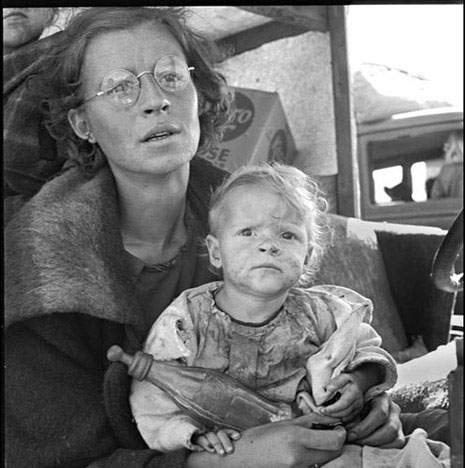
It turns out, however, that Dorothea Lange made several photographs of this young mother and her children on that day in 1939.
Here’s another one. This photo, for obvious reasons, is not iconic. The child’s face is freshly scrubbed, and both mother and child are smiling. It feels wrong and makes the viewer wonder what’s going on.
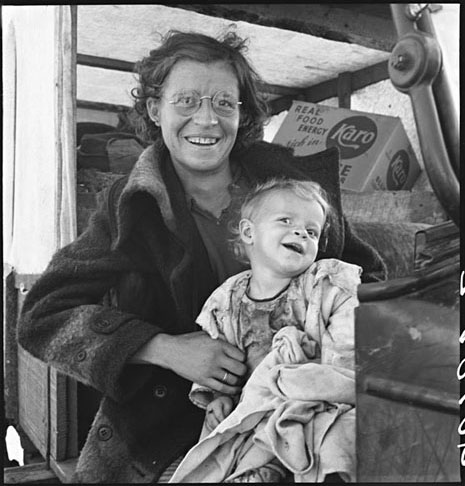
In fact, this is Lange’s explanation in the general caption that she wrote:
Father washed the baby’s face with edge of blanket dampened from canteen, for the photographs.
There you go. The father washed his child’s face. He manipulated reality, and Lange let him do it. Together they’ve created a lie.
The problem isn’t with the photo, however. The photo is real. The problem is with us.
The “correct” photo confirms our expectation and is, so to say, politically correct. The “false” one not. See? We’re even expecting a message from a photograph. That, again, is a process as found in politics: bridging the gap between real and intended/aimed at/promised reality.
A photograph fulfills specific roles and functions according to the context. Suggestions that set photography only within an artist as “genius” mode or see the images as simply reflections of reality, they fail to respond to the deeper nature of what a photograph really is.
Photography is always a response to the nature of culture and social construction, and therefore political in nature. Any photography that fails to embrace the social and cultural context does not only talk to itself alone, but has also little or nothing to say. The best photographs challenge even entrenched beliefs.
Because photography, good photography, cannot be unaffected. It is always compassionate and touched by the subject/object. Good photography is judging, critical and descriptive — even landscape and macro photography.
Good photography is storytelling; storytelling about people, about life, about issues that challenge and engage. Photography therefore ought to always dare to be involved. This very attempt to portray and tackle any issue breathes life into photography. Without trying to be involved photography would be a futile, static, dead exercise.
So… if photographs are an interpretation of any reality suggesting a different, manipulated reality, do photographs lie? They’re capable of doing so. Politics have relied upon these “white lies” suggested by photographs since photography’s inception to forge a specific image of governments, religions, dictatorships, corporations or whatever.
And darn! Where is the praised artistry of photography in all that?
Creativity is a highly subjective undertaking rather than an objective one. Same is valid for the highly creative process of photography. Not two people are capable of executing the exactly same shot. Photography is no exact science. Depicting reality however is not always the subject of art, but it’s the subject of photography. Hence, photography acts as a conscience, looking at the world, humanity and our existence, showing us who and what we are, where we come from and where we are headed.
Until the threshold of the modern era, people didn’t really “know” many answers to these fundamental questions. Control over “truth” a.k.a. visual representation remained in the hands of the ruling classes. Only the recent technologization and especially the phenomenon of access to information with cheap imaging sensors and so forth empowered the masses.
We’re living the power of information. Images are an essential part of this.
Today, more people than ever practice photography as a form of art that tries to document and seek out beauty and truths. Modern-day photography exposes injustice and the corrupt and is therefore more political in many ways than a political platform.
Because every photograph carries a message.
You just don’t see that when you look at the pixels only. See the “whole picture.”
Really seeing an image makes less vulnerable to being manipulated, as there is virtually nothing, especially in photography, that is not some sort of propaganda a.k.a. politics.
We practice politics, whether we know it or not, every day in our dealings with other people. Every single decision you make in your everyday life has some underlying political dimenison, so you cannot divide between politics and photography.
Every photo is political as it contains some kind of point of view. You simply cannot wash the politics out of photography. What creates trouble is not a photo with political content but the viewer’s inablity to step back and try to look at the other point of view presented in a dispassionate manner.
Photography has captured and will continue to capture our societies, along with the political, social and cultural environments that thrive in (on) them.
After all, photography is first and foremost always about — and that’s important — free speech.


